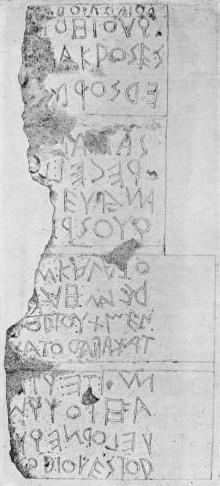History of Latin
History of Latin
The History of Latin traces the development of the Latin language from its origins in the Italic languages of Ancient Italy to its modern forms as the Ecclesiastical Latin used by the Roman Catholic Church and as the Romance languages spoken globally. Latin, originally spoken by small groups of people living along the lower Tiber River, became the language of the Roman Republic and later the Roman Empire. Over centuries, Latin evolved and spread, influencing languages and cultures throughout Europe and parts of Africa and Asia.
Origins and Early History[edit | edit source]
Latin belongs to the Italic branch of the Indo-European languages, with its earliest known forms appearing in the 7th century BCE. It was initially influenced by the Etruscan language and Greek, as evidenced by the Latin alphabet, which was derived from the Greek alphabet through the Etruscan. The oldest known Latin inscription, the Praeneste fibula, dates back to around the 7th century BCE.
Classical Latin[edit | edit source]
The period of Classical Latin, which spanned from the late Roman Republic to the early Roman Empire, is marked by the works of authors such as Cicero, Virgil, and Caesar. This era's Latin is characterized by its standardized grammar and vocabulary, largely due to the influence of literary and educational norms. Classical Latin served as a lingua franca across the Roman Empire, facilitating communication and cultural integration.
Vulgar Latin and the Romance Languages[edit | edit source]
With the decline of the Roman Empire, Latin began to diverge into various regional forms, collectively known as Vulgar Latin. These vernacular dialects, influenced by local languages and the social and political changes of the time, gradually evolved into the distinct Romance languages we recognize today, including Spanish, Portuguese, French, Italian, and Romanian.
Medieval and Ecclesiastical Latin[edit | edit source]
During the Middle Ages, Latin continued to serve as an important lingua franca, especially in the realms of religion, scholarship, and government. Medieval Latin saw the introduction of many new terms and concepts, particularly in the fields of theology and philosophy. Meanwhile, Ecclesiastical Latin emerged as a standardized form of the language used by the Roman Catholic Church, which has been maintained up to the present day.
Renaissance Latin[edit | edit source]
The Renaissance period witnessed a revival of interest in Classical Latin, with scholars striving to return to the purity of its form and style. This movement, known as the Humanist movement, produced a body of Latin literature that paralleled the achievements of the ancients, while also contributing to the development of the Romance languages.
Modern Latin[edit | edit source]
In the modern era, Latin has largely become a dead language, no longer spoken as a native language by any community. However, it remains in use in certain contexts, such as in the terminology of law, medicine, and science, and as the official language of the Vatican City. Latin phrases and roots continue to be used in the creation of new terms in various languages, reflecting its enduring influence on the linguistic heritage of the Western world.
Conclusion[edit | edit source]
The history of Latin is a testament to the language's adaptability and enduring legacy. From its humble beginnings in Ancient Italy to its status as the foundation of the Romance languages and a significant element of Western scholarship and culture, Latin has played a crucial role in shaping the linguistic and cultural landscape of the Western world.
This article is a linguistics stub. You can help WikiMD by expanding it!
Search WikiMD
Ad.Tired of being Overweight? Try W8MD's physician weight loss program.
Semaglutide (Ozempic / Wegovy and Tirzepatide (Mounjaro / Zepbound) available.
Advertise on WikiMD
|
WikiMD's Wellness Encyclopedia |
| Let Food Be Thy Medicine Medicine Thy Food - Hippocrates |
Translate this page: - East Asian
中文,
日本,
한국어,
South Asian
हिन्दी,
தமிழ்,
తెలుగు,
Urdu,
ಕನ್ನಡ,
Southeast Asian
Indonesian,
Vietnamese,
Thai,
မြန်မာဘာသာ,
বাংলা
European
español,
Deutsch,
français,
Greek,
português do Brasil,
polski,
română,
русский,
Nederlands,
norsk,
svenska,
suomi,
Italian
Middle Eastern & African
عربى,
Turkish,
Persian,
Hebrew,
Afrikaans,
isiZulu,
Kiswahili,
Other
Bulgarian,
Hungarian,
Czech,
Swedish,
മലയാളം,
मराठी,
ਪੰਜਾਬੀ,
ગુજરાતી,
Portuguese,
Ukrainian
Medical Disclaimer: WikiMD is not a substitute for professional medical advice. The information on WikiMD is provided as an information resource only, may be incorrect, outdated or misleading, and is not to be used or relied on for any diagnostic or treatment purposes. Please consult your health care provider before making any healthcare decisions or for guidance about a specific medical condition. WikiMD expressly disclaims responsibility, and shall have no liability, for any damages, loss, injury, or liability whatsoever suffered as a result of your reliance on the information contained in this site. By visiting this site you agree to the foregoing terms and conditions, which may from time to time be changed or supplemented by WikiMD. If you do not agree to the foregoing terms and conditions, you should not enter or use this site. See full disclaimer.
Credits:Most images are courtesy of Wikimedia commons, and templates, categories Wikipedia, licensed under CC BY SA or similar.
Contributors: Prab R. Tumpati, MD





